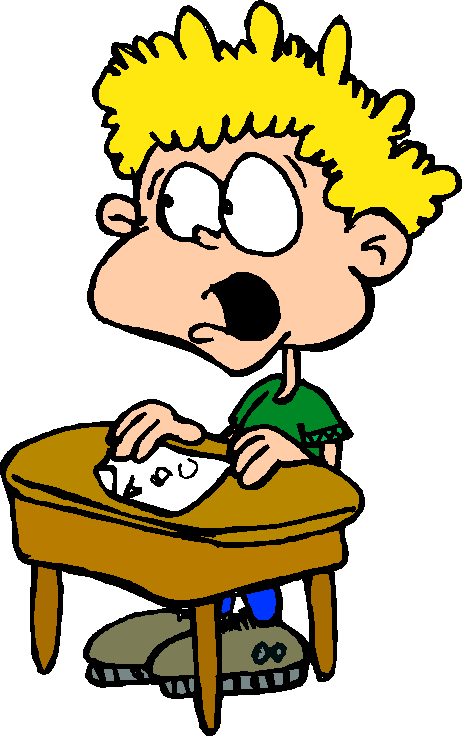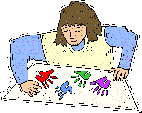MARCHING TO THE BEAT OF A DIFFERENT DRUMMER
THE CREATIVE UNDERACHIEVER
Underachieving
children are not always creative, and creative children are
not always underachievers. However, an alarming number of highly
creative children do not achieve to their  abilities in school.
Parents of those highly creative children frequently conclude
with a certain amount of pride that "their child has always
seemed to march to the beat of a different drummer."
abilities in school.
Parents of those highly creative children frequently conclude
with a certain amount of pride that "their child has always
seemed to march to the beat of a different drummer."
Both creative achievers and underachievers have been given early messages about the importance of creativity by at least one parent. The messages come most simply from the praise given to them for their creative products and actions. They learn that when they do something unusual, or if they have a funny or different idea, it brings attention. Creative thinking becomes a personal motivational goal, which won't necessarily lead to underachievement if home and school environments cooperate to foster the creative process.
An early indicator of a potential problem will appear in the differential valuing of the child's creativity by two parents. The child that identifies with the creative parent is likely to be creative; but if the other parent doesn't value creativity, the seeds of opposition and underachievement may be planted.
EARLY AGES SHOW TELLTALE SIGNS
At elementary level, creative children may be seen as achievers, although the telltale signs of creative opposition are usually already visible. They often voice complaints about boring reading workbooks and teachers that don't like them, and parents may ally with them against the teacher or ask for less busywork or request an extension for assignments. Parent conversations with other adults that take place within 
As the parent sides with the child against the school, the child learns to avoid school responsibility and to blame the boring school curriculum for his/her problems. In the powerful alliance of child and parent, the child gains too much power and becomes engaged in a subtle struggle with his/her teacher in the name of creativity. Within this struggle are the seeds of the pattern of determined and oppositional nonconformity. The child has begun his/her march to the beat of an even different drummer.
PRESSURES CREATIVE YOUNG
ARE FACED WITH
Creative young people are faced with paradoxical pressures. Their internalized value system says to "be creative." They translate that to mean "don't ever conform." However, achievement requires some conformity. Peers are also demanding their conformity for acceptance. Conforming to friends seems antithetical to their wishes to be creative. During the preadolescent years, creative underachievers are typically unhappy, often unappreciated by parents, teachers, and peers alike.
By senior high school, opposition is
firmly entrenched and is a way of life. The opposition
that began as an alliance between a parent and a teacher
has expanded to become opposition  against one or both
parents and any number of teachers. Sometimes, the adolescent
will be successful in getting Mom on his/her side against
Dad, or vice versa. Either or both parents may share
in their protest against the school. The most likely
alliance group of all, however, will be an oppositional
peer group, preferably one that identifies itself as
"different." The creative underachiever has
finally found acceptance by friends who value, most
of all, nonconformity and opposition.
against one or both
parents and any number of teachers. Sometimes, the adolescent
will be successful in getting Mom on his/her side against
Dad, or vice versa. Either or both parents may share
in their protest against the school. The most likely
alliance group of all, however, will be an oppositional
peer group, preferably one that identifies itself as
"different." The creative underachiever has
finally found acceptance by friends who value, most
of all, nonconformity and opposition.

Ideal home and school environments that foster both creativity and achievement include parents and teachers that value creativity within the limits of reasonable conformity. That is, children are praised and encouraged in unusual and critical thinking and production, but this difference does not become a device or a manipulation for avoidance of academic or home responsibility. If in any way creativity takes on a ritualized position of avoiding a parent's requirements or the school's expectations, then creativity will be used as "a way out" of achievement. Here are some recommendations for parents and teachers for the prevention and/or cure of underachievement in creative children:
- A parent should not, if at all possible, ally with a child against a teacher in the name of creativity. Parents should communicate their concerns to teachers, but it must be done carefully so the teachers or school are not "put down" in the process, and the child doesn't view this as an excuse for not fulfilling school expectations.
- One parent shouldn't ally with a child against another parent in the name of creativity or permit the child's creative needs to be the excuse for not doing what the other parent requests. This may cause the child to become rebellious with creativity as his/her excuse.
- Encourage creative children to be productive in at least one area of creative expression, and help them to find an audience for their performances. Children that are happily and productively involved in creative arenas are less likely to be using their energy to fight authority. Whether their choice of creative expression is art, drama, music, or science, a creative outlet frees them of some of their internalized pressure to be nonconformists in other areas. Be sure, however, not to permit them to use that creative outlet as a means of evading academic assignments.
- Don't label one child in the family "the creative child." It causes that child to feel pressured to be most creative all the time and causes other siblings to believe that creativity is not possible for them at all.
- Find appropriate models and mentors in areas of children's creativity. Creative children, particularly in adolescence, too easily discover inappropriate models that may also be creative underachievers. Appropriate models should share their creative talent area, but must also give the message of self-discipline and reasonable conformity, which the underachievers have not developed. The model should be an achieving, creative person.
- Find a peer environment that combines creativity and achievement so that creative children may feel comfortably accepted by other achieving and creative young people. Gifted resource programs frequently provide a haven for creative underachievers provided the identification process has not eliminated them from participation. There are many summer opportunities for drama, music, art, photography, computers, science, math, or foreign languages that provide excellent creative outlets.
- Encourage intrinsic motivation while also teaching competition. Children should learn to enjoy the creative process for the joy and satisfaction of their personal involvement. However, they should not be permitted to entirely avoid the competitive arena. They should experience a balance of winning and losing to build confidence.
- Use creative strengths to build up weaknesses. Children don't have to be equally strong in all areas, but they do have to accomplish at least minimally in school-required subjects so that they don't close educational doors for themselves. Creative children will often find their own solutions to dealing with their weaknesses, and some flexibility and encouragement on the part of teachers will foster creative solutions.
- Avoid confrontations, particularly if you can't control the outcomes. This is not an excuse to avoid firmness and reasonable consequences, but it is a warning to prevent overreaction, overpunishment, and the continuous struggles and battles that often plague the creative adolescent's environment. Modeling and sharing positive work and play experiences are more effective than lectures and threats.
- Help creative adolescents to plan a creative future. Though they are underachievers at this time, it's most critical that they understand that most creative careers are open only to achievers. If they're unwilling to compromise and conform to reasonable requirements, they're likely to close doors to future creative opportunities.
There is a precarious balance between creativity and oppositionality. Creative children often feel so internally pressured to be creative that they define their personal creativity only as nonconformity. If they're unwilling to conform at least minimally, they risk losing the opportunities to develop their unique talents. If parents and teachers avoid facilitating avoidance of responsibility in the name of creativity, creative children can channel their important talent toward productive contributions and feel better about themselves.
©2001 by Sylvia B. Rimm. All rights reserved. This publication, or parts thereof, may not be reproduced in any form without written permission of the author.
